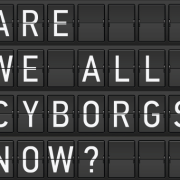The Greeks had a myth which told of an artist, Pygmalion, who fell in love with an ivory woman he sculpted. The goddess Aphrodite granted life to the statue, who then bore Pygmalion a daughter. In the Pygmalion myth, when matter comes to life it is benign, even salvific.
The Pygmalion archetype surfaces in modern times, especially after the industrial revolution. But in the modern reworking of this archetype there is a crucial difference: when our creations come alive, they are not life-giving but life-consuming. From Mary Shelley’s 1818 novel Frankenstein to the 1999 movie The Matrix through to Jonathan Nolan’s Person of Interest (2011–2016), writers have explored the implications of machines taking on human-like characteristics and turning hostile.
We should attend to this tradition of techno-dystopianism because it promises to teach us something about ourselves. We can tell a lot about a culture’s fears, including fears that fester in a latent and unconscious form, by looking at the angst that emerge in cultural stories and myths. For example, in the 19th century when the theories of Darwin were taking root in public consciousness, a number of stories (most famously Stevenson’s Strange Case of Dr Jekyll and Mr Hyde) gave voice to the fear that the demarcation between man and beast might be porous. Similarly, the current popularity of contemporary stories about AI are tapping into latent anxieties that humanity is being conquered, or at least marginalized, by artificial intelligence.
When stories and art give rise to latent anxieties, they do so in a way that is often not straightforward and requires interpretation. The human imagination, like our dreams, often express itself in symbols and archetypes that need to be unpacked. The werewolf and vampire myths are examples of this, where legitimate and real human fears became externalized and expressed in myth. While it would be a mistake to take such myths literally, it is equally a mistake to discount them as mere fantasy.
Similarly, we should attend carefully to our own myths about a looming computer take-over. We should try to discern what they have to teach us about ourselves and our anxieties. When we do, we find that there is objective legitimacy in the concern that humanity is being marginalized by our machines, and specifically by AI. Yet to the degree that this concern has been externalized onto fear of robots—a kind of dark reversal of the Pygmalion myth—this obscures the real nature of what is going on.
What is actually going on is not that our machines are becoming human-like, but that humans are becoming machine-like. From my article, “The AI Apocalypse is Happening Right Now…but not in the way you think.”
Could that be the real AI apocalypse that we should be worried about? Not machines taking over and acquiring agency, and not machines evolving their own intentionality, but human beings creating a world customized for the flourishing of machines? Did we cede power to our machines as soon as we began customizing our world so that they (these stupid machines) could appear much more smart, necessary and indispensable than they actually are? Within machine-oriented infrastructures, new problems come to exist that never existed for our ancestors, and to solve these problems we have to capitulate to even deeper levels of machine-dependence. One example of this is the move towards digital identification, which seeks to solve a problem created by the unnatural condition of human beings living in the infosphere (i.e., an environment customized for machines). Microsoft journalist Jason Ward observes that “Participation in the modern economy, the ability to buy and sell, attain employment, healthcare, social services and more are virtually impossible without a digital identity.” Microsoft’s solution to this problem is to partner with governments to funnel the entire world’s population into infrastructures that allow each and every person to have a unique “digital identity.”


